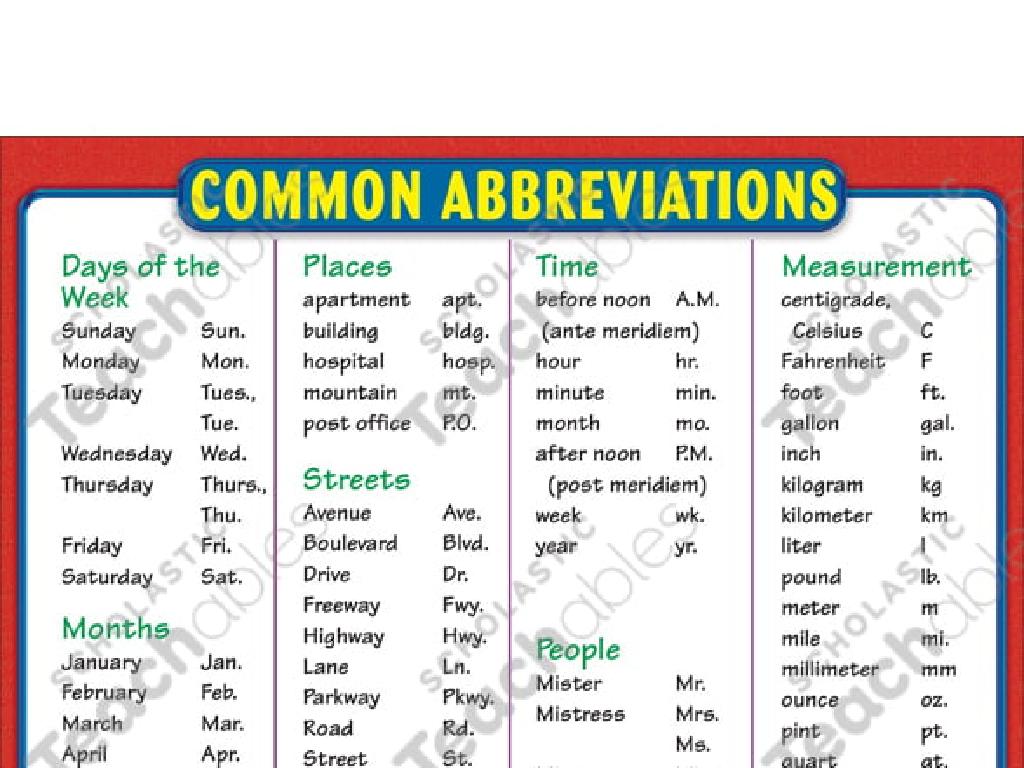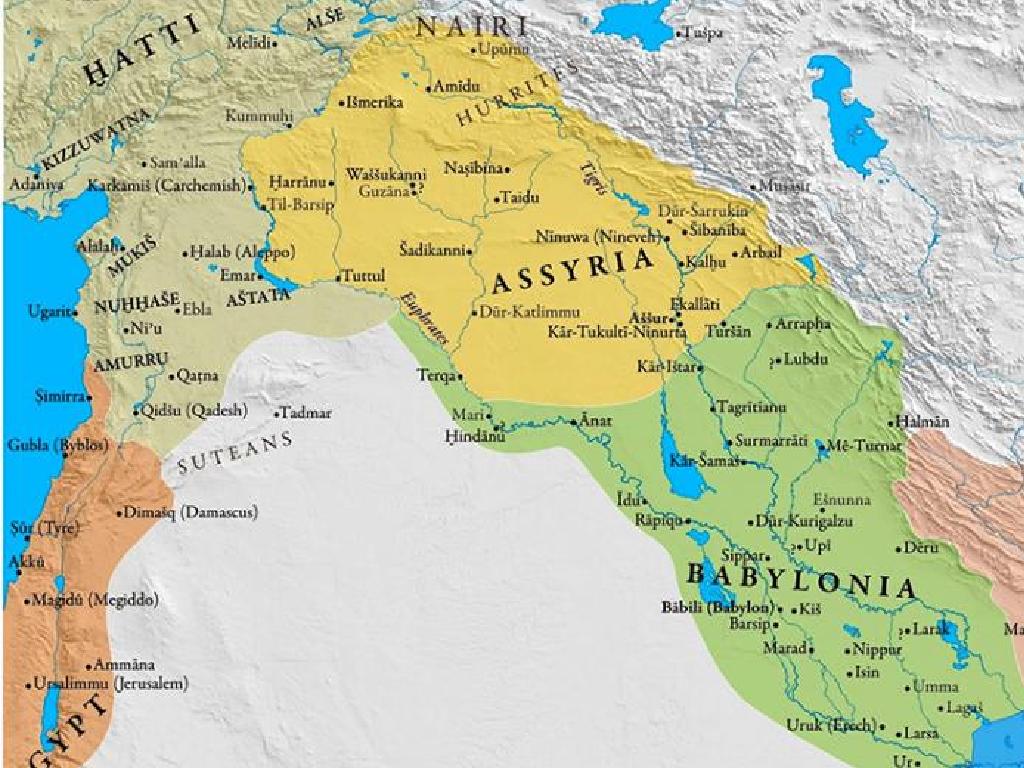Identify Earth'S Land Features Using Photographs
Subject: Social studies
Grade: Sixth grade
Topic: Physical Geography
Please LOG IN to download the presentation. Access is available to registered users only.
View More Content
Exploring Earth’s Land Features
– What is Physical Geography?
– Study of Earth’s natural environments
– Earth’s diverse land features
– Mountains, valleys, plains, and more
– Identifying features in photos
– Use clues in photos to recognize features
– Today’s photo analysis activity
|
This slide introduces students to the field of physical geography, emphasizing the study of Earth’s natural environments, including landforms, climates, and ecosystems. Highlight the diversity of Earth’s land features such as mountains, valleys, plains, and plateaus. Explain how photographs can be a valuable tool for identifying these features by looking for visual clues like shape, size, and patterns. The class will engage in a photo analysis activity where they will apply their knowledge to identify different land features from a set of photographs. Encourage students to describe the features they see and discuss how these features might have formed. This activity will help students develop observational skills and a deeper appreciation for Earth’s physical geography.
Exploring Earth’s Land Features
– Physical Geography defined
– The study of Earth’s natural landscapes and processes
– Investigate mountains, rivers, deserts
– Examine various landforms and their characteristics
– How land shapes our environment
– Understand the role of natural features in ecosystems
– Impact on human activities
– Explore how geography influences settlement, culture, and economy
|
This slide introduces students to the concept of Physical Geography, which is the branch of geography dealing with natural features and processes of the Earth. It encourages students to explore different types of landforms such as mountains, rivers, and deserts, and to consider how these features not only shape the physical world but also affect human activities and the environment. Students should be prompted to think about the relationship between the Earth’s natural features and the development of civilizations, climate patterns, and biodiversity. The slide sets the stage for further discussion on the importance of geography in understanding our planet and its various ecosystems.
Exploring Earth’s Land Features
– Mountains: Majestic elevations
– Tall landforms, often rocky, formed by tectonic forces or volcanism
– Valleys: Land nestled between
– Gently sloping areas situated between mountains or hills
– Plains: Expansive flatlands
– Vast, level areas where grasses often grow, used for agriculture
– Deserts: Arid, sparse landscapes
– Extremely dry areas with scarce vegetation and rainfall
– Plateaus: Raised flat regions
– High, flat terrain with one or more steep sides, found worldwide
|
This slide introduces students to various land features found on Earth, providing a visual understanding of physical geography. Mountains are natural elevations often characterized by their impressive height and ruggedness. Valleys are the lower areas that lie between hills or mountains, usually with a river running through them. Plains are large stretches of flat or gently undulating land, often used for farming due to their fertile soils. Deserts are known for their dry conditions, sandy landscapes, and minimal rainfall. Plateaus are flat, elevated areas that rise abruptly from the surrounding land. Encourage students to observe these features in photographs and discuss how they might have formed. This will help them connect the visual information with the physical processes that shape our planet.
Observing Earth’s Land Features
– Identifying features in photos
– Use photos to spot mountains, valleys, etc.
– Clues: shape, size, location
– Look for unique characteristics
– Comparing various landforms
– How are a mountain and a hill alike?
– Contrast to understand differences
– How do a plateau and plain differ?
|
This slide aims to teach students how to identify and analyze different land features using photographs. Encourage students to observe the shape, size, and location as primary clues. For example, mountains will have a distinct peak, while valleys will appear as low areas between hills or mountains. Discuss how to compare features, such as the similarities between hills and mountains (both rise above surrounding land) and how to contrast them, like understanding the difference between a plateau (flat-topped) and a plain (flat and extensive land). Use a variety of photographs to illustrate these features and ask students to describe what they see. This will help them to visually differentiate and categorize landforms in their minds, which is a key skill in physical geography.
Mountains and Valleys: Earth’s Majestic Landforms
– Characteristics of mountains
– High elevation, steep slopes, rugged terrain
– Formation of valleys
– Valleys form between mountains, often due to erosion
– Example: The Rocky Mountains
– A famous mountain range in North America
– Example: The Grand Canyon
– A vast valley known for its size and colorful landscape
|
This slide aims to help students identify and understand the physical features of mountains and valleys through photographs. Discuss the characteristics of mountains such as their elevation, steepness, and ruggedness. Explain how valleys are formed, often as a result of erosion by rivers or glaciers. Use photographs of the Rocky Mountains to illustrate the typical features of a mountain range. Show images of the Grand Canyon to demonstrate a valley’s scale and how erosion shapes the landscape. Encourage students to observe these features in the photographs and relate them to the concepts discussed. This visual approach will enhance their grasp of physical geography and the processes that shape our Earth’s surface.
Exploring Plains and Plateaus
– Characteristics of plains
– Vast, open lands, often used for farming
– Defining plateaus
– Elevated areas with flat tops and steep sides
– Example: The Great Plains
– Stretch across central North America, known for agriculture
– Example: The Colorado Plateau
– Located in the western United States, known for its unique geology
|
This slide aims to help students identify and differentiate between plains and plateaus using photographs. Plains are characterized by their vast, open spaces that often make them ideal for agriculture. In contrast, plateaus are elevated areas with flat tops and steep sides, which can be seen in their distinct topography. Use photographs of The Great Plains to show the expanse of flat agricultural land, and contrast with images of the Colorado Plateau to highlight its elevated, rugged terrain. Encourage students to discuss how these landforms might have been formed and their importance to human activity and the environment.
Exploring Deserts: Earth’s Arid Landscapes
– Deserts: Dry and sparse
– Characterized by little rain and few plants
– Plant and animal adaptations
– Special traits for survival in harsh conditions
– The Sahara: A desert case study
– World’s largest hot desert, iconic dunes
– Understanding desert ecosystems
|
This slide aims to introduce students to the concept of deserts as a significant land feature on Earth. Emphasize the arid nature of deserts, typically receiving less than 25 centimeters of rain annually, and the resulting sparse vegetation. Discuss how plants and animals have adapted to survive with minimal water, extreme temperatures, and limited food sources. Use the Sahara Desert as a specific example to illustrate the vastness and variety within desert landscapes. Encourage students to think about how these adaptations help organisms survive and how deserts play a role in Earth’s overall ecosystem. This will help students appreciate the diversity of physical geography on our planet.
Class Activity: Land Feature Detective
– Form small detective groups
– Analyze land feature photos
– Look closely at the shapes, colors, and textures in the photos
– Identify different land features
– Use your knowledge to determine if it’s a mountain, valley, plain, etc.
– Present findings to the class
|
In this engaging class activity, students will work in small groups to act as ‘Land Feature Detectives.’ Each group will receive a set of photographs depicting various land features. They will use their observational skills and knowledge from previous lessons to analyze and identify the land features shown in the photographs. Encourage students to discuss within their groups and come to a consensus on the types of land features they believe are represented. After the analysis, each group will present their findings to the class, explaining how they identified each feature. This activity will help reinforce their understanding of physical geography and improve their teamwork and presentation skills. Possible activities for different groups could include identifying mountain ranges, river systems, deserts, plateaus, and other landforms.
Review and Reflection: Earth’s Land Features
– Recap of land features
– Impact on environment and life
– How do mountains/rivers shape the ecosystem or influence where people live?
– Q&A session for doubts
– Reflect on today’s learning
– Think about how these features affect daily life and the planet.
|
This slide aims to consolidate the day’s learning about Earth’s physical geography, focusing on various land features such as mountains, valleys, rivers, and plains. Encourage students to think about the role these features play in shaping the environment, such as how mountains can affect climate or rivers can support civilizations. During the Q&A session, address any uncertainties the students may have, ensuring they have a clear understanding of the material. Finally, ask students to reflect on what they’ve learned and how it connects to the wider world, emphasizing the relevance of geography in their everyday lives.
Homework: Local Land Features Exploration
– Find a photo of a local land feature
– Write a description for the feature
– Describe what the feature is, like a mountain, river, etc.
– Explain the feature’s significance
– Why is this feature important to our area or history?
– Share your findings in class
|
This homework assignment is designed to connect students with their local geography and enhance their understanding of physical land features. Students are tasked with finding a photograph of a land feature that is local to them, such as a nearby mountain, river, or valley. They must then write a short description of the feature, identifying what it is and including details such as its size, shape, and location. Additionally, students should research and explain the significance of the feature, considering aspects such as ecological importance, historical relevance, or its role in the community. Encourage students to think critically about how these features shape their environment. In the next class, students will have the opportunity to share their photographs and findings, fostering a discussion on the diversity of the local landscape and its impact on the region.






